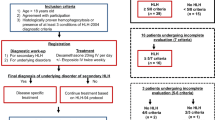Abstract
Our aim was to evaluate the clinical value of splenectomy as a treatment for relapsed hemophagocytic lymphohistiocytosis (HLH) of unknown cause in adults. We retrospectively reviewed the clinical data from medical records of 19 adults with relapsed HLH of unknown cause treated with splenectomy in our institution from June 2007 to March 2014. To rule out possible underlying diseases, including infection, autoimmune disease, neoplasms, and primary HLH, the patients had undergone examinations including F18 fluoro-2-deoxyglucose positron emission tomography/computed tomography, HLH-associated gene defects, and lymph node biopsies. Twelve patients (63.2 %) achieved partial responses (PR), whereas seven patients (36.8 %) had no response (NR) prior to splenectomy. Infection and hemorrhage were the main complications of splenectomy. Eighteen cases were evaluable after follow-up. Seven cases with histopathologic diagnoses of lymphoma had received chemotherapy, four of whom had achieved complete responses (CR), one PR, and two NR. Maintenance treatment was ceased 2 or 3 months after splenectomy in the other 11 cases, five of whom had CR, four PR, and two NR. Eleven of 18 cases (61.1 %) survived with a median follow-up of 25 months (range 3–79 months) for survivors. Twelve- and 36-month progression-free survival rates were 48 and 24 %, respectively; 12- and 36-month overall survival rates were 57 and 25 %, respectively. Median survival time was 22 months. Our results indicate splenectomy may be an effective means of diagnosis and treatment of relapsed HLH of unknown cause. Further study is required to establish the mechanism and value of splenectomy in this disease.


Similar content being viewed by others
References
Verbsky JW, Grossman WJ (2006) Hemophagocytic lymphohistiocytosis: diagnosis, pathophysiology, treatment, and future perspectives. Ann Med 38:20–31
Henter JI, Horne A, Aricó M et al (2007) HLH-2004: diagnostic and therapeutic guidelines for hemophagocytic lymphohistiocytosis. Pediatr Blood Cancer 48:124–131
Marsh RA, Allen CE, McClain KL et al (2013) Salvage therapy of refractory hemophagocytic lymphohistiocytosis with alemtuzumab. Pediatr Blood Cancer 60:101–109
Tarantino G, Savastano S, Capone D et al (2011) Spleen: a new role for an old player? World J Gastroenterol 17:3776–3784
Imashuku S, Obayashi M, Hosoi G et al (2000) Splenectomy in haemophagocytic lymphohistiocytosis: report of histopathological changes with CD19+ B-cell depletion and therapeutic results. Br J Haematol 108:505–510
Zhang LJ, Zhang SJ, Xu J (2011) Splenectomy for an adult patient with refractory secondary hemophagocytic lymphohistiocytosis. Biomed Pharmacother 65:432–435
Wang YN, Wang Z, Wu L et al (2009) A multicenter retrospective analysis of diagnosis and treatment of 72 hemophagocytic syndrome patients. Chin J Hematol 30:793–798
Das-Gupta T, Coombes B, Brasfield RD (1965) Primary malignant neoplasms of the spleen. Surg Gynecol Obstet 120:947–960
Brox A, Shustik C (1993) Non-Hodgkin’s lymphoma of the spleen. Leuk Lymphoma 11:165–171
Han SM, Teng CL, Hwang GY et al (2008) Primary splenic lymphoma associated with hemophagocytic lymphohistiocytosis complicated with splenic rupture. J Chin Med Assoc 71:210–213
Suzuki S, Uozumi K, Utsunomiya A et al (2008) Aggressive NK cell leukaemia after splenectomy: association with CD95-resistant memory T-cell proliferation and recalcitrant clinical course of haemophagocytic syndrome. Eur J Haematol 81:236–241
Kim J, Yoo SW, Kang SR et al (2014) Clinical implication of F-18 FDG PET/CT in patients with secondary hemophagocytic lymphohistiocytosis. Ann Hematol 93:661–667
Shin HJ, Chung JS, Lee JJ et al (2008) Treatment outcomes with CHOP chemotherapy in adult patients with hemophagocytic lymphohistiocytosis. J Korean Med Sci 23:439–444
Dunn T, Cho M, Medeiros B et al (2012) Hemophagocytic lymphohistiocytosis in pregnancy: a case report and review of treatment options. Hematology 17:325–328
Chellapandian D, Das R, Zelley K et al (2013) Treatment of Epstein Barr virus-induced haemophagocytic lymphohistiocytosis with rituximab-containing chemo-immunotherapeutic regimens. Br J Haematol 162:376–382
Adachi S, Kubota M, Akiyama Y et al (1997) Successful bone marrow transplantation from an HLA-identical unrelated donor in a patient with hemophagocytic lymphohistiocytosis. Bone Marrow Transplant 19:183–185
Zhang BJ, Men XJ, Lu ZQ et al (2013) Splenectomy protects experimental rats from cerebral damage after stroke due to anti-inflammatory effects. Chin Med J (Engl) 126:2354–2360
Chu W, Li M, Li F et al (2013) Immediate splenectomy down-regulates the MAPK-NF-kappaB signaling pathway in rat brain after severe traumatic brain injury. J Trauma Acute Care Surg 74:1446–1453
Chuang H-C, Lay J-D, Hsieh W-C, Su I-J (2007) Pathogenesis and mechanism of disease progression from hemophagocytic lymphohistiocytosis to Epstein–Barr virus-associated T-cell lymphoma: nuclear factor-κB pathway as a potential therapeutic target. Cancer Sci 98:1281–1287
Jordan MB, Allen CE, Weitzman S et al (2011) How I treat hemophagocytic lymphohistiocytosis. Blood 118:4041–4052
Acknowledgments
This work was supported by the National Natural Science Fund (81270653), Beijing Natural Science Fund (7132087), Public Health Project of Science and Technology Committee of the Beijing Municipal Development projects (Z131100006813041), and Friendship Hospital research fund (yyqdkt2013-10).
Conflict of interest
The authors declare that they have no conflict of interest.
Author information
Authors and Affiliations
Corresponding author
Rights and permissions
About this article
Cite this article
Jing-Shi, W., Yi-Ni, W., Lin, W. et al. Splenectomy as a treatment for adults with relapsed hemophagocytic lymphohistiocytosis of unknown cause. Ann Hematol 94, 753–760 (2015). https://doi.org/10.1007/s00277-014-2276-9
Received:
Accepted:
Published:
Issue Date:
DOI: https://doi.org/10.1007/s00277-014-2276-9




